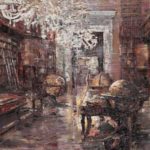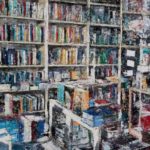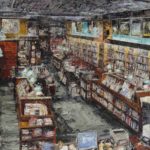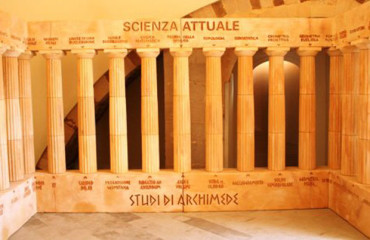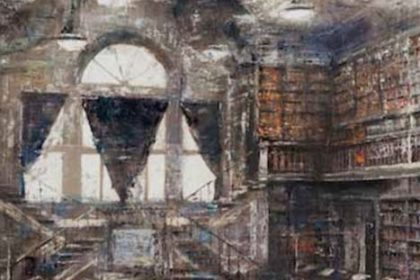
Shelves full, environments populated of bond paper, chairs and tables for studying, precious objects that are preserved in places of culture. The series dedicated to bookstores and libraries by Massimo Giannoni (Empoli, 1954, lives and works in Florence) are long glances that investigate memory and transmission of knowledge and put in the middle the places where volumes live. Because the protagonists are them, books: shapes, colored backs, the solid masses and yet so familiar and light. Here and there appear displayers of recognizable magazines, plausible covers, neat piles of books or stacks of tomes waiting for a reorganization, or waste, and then a few extraneous things: some ladder to reach the higher rows, a couple of globes, an antique vase, all in a balanced rate of solids and voids.
However there is never human presence in the environments containing books, many of which have now disappeared, like the famous Seeber Library of Florence, whose views become almost an appeal against the danger of extinction of the old, charming shops; it is as if knowledge was living its own life, it did not need to be used, browsed, learned. Constant and palpable presence on the contrary the light, sometimes golden to light a corner between the shelves, sometimes neon that flattens and makes the atmosphere colder, in a color contrast that often alternates with large portions of the painting almost monochrome, where the gray scale is touched only by a little blue.
The stated source of Giannoni’s frameworks is photography medium: a simple base from which to build a complex system of image that chooses a particular perspective – clear views from above or below that they perceive as a basic element of the painting, not as simple necessity – and knead dense layers of color to make the material works, tactile, even more true of the same photograph of departure, so as to bring out from paintings authentically three-dimensional details. And Giannoni, with his technique, consciously touches also the informal, in an effective contamination that maintains a high attention of the beholder and that proves central to the artist: the “how” of painting, as much as the “what”.
Giannoni lives in his studio, he needs his atelier, of silence, of solitude and time that does not flow and that he portrays on his paintings: there he thinks and realizes his multitudes – term, along with “accumulations”, often is used in his statements or in the texts that speak of him – of books, landscapes and interiors of business bags with busy and agitated men. He claims to be mysteriously in love with his subjects, to which he devoted himself with method and rigor, pursuing an immediate recognition that distinguishes him from too fickle artistic spirits and that trace a path that runs along with professionalism and consistency.
Cover: Massimo Giannoni, Library, 2014 – Courtesy of the artist
 English
English  Italiano
Italiano 

